Proteomics Technologies - PDF
VerifiedAdded on 2021/02/20
|13
|2663
|310
AI Summary
Contribute Materials
Your contribution can guide someone’s learning journey. Share your
documents today.
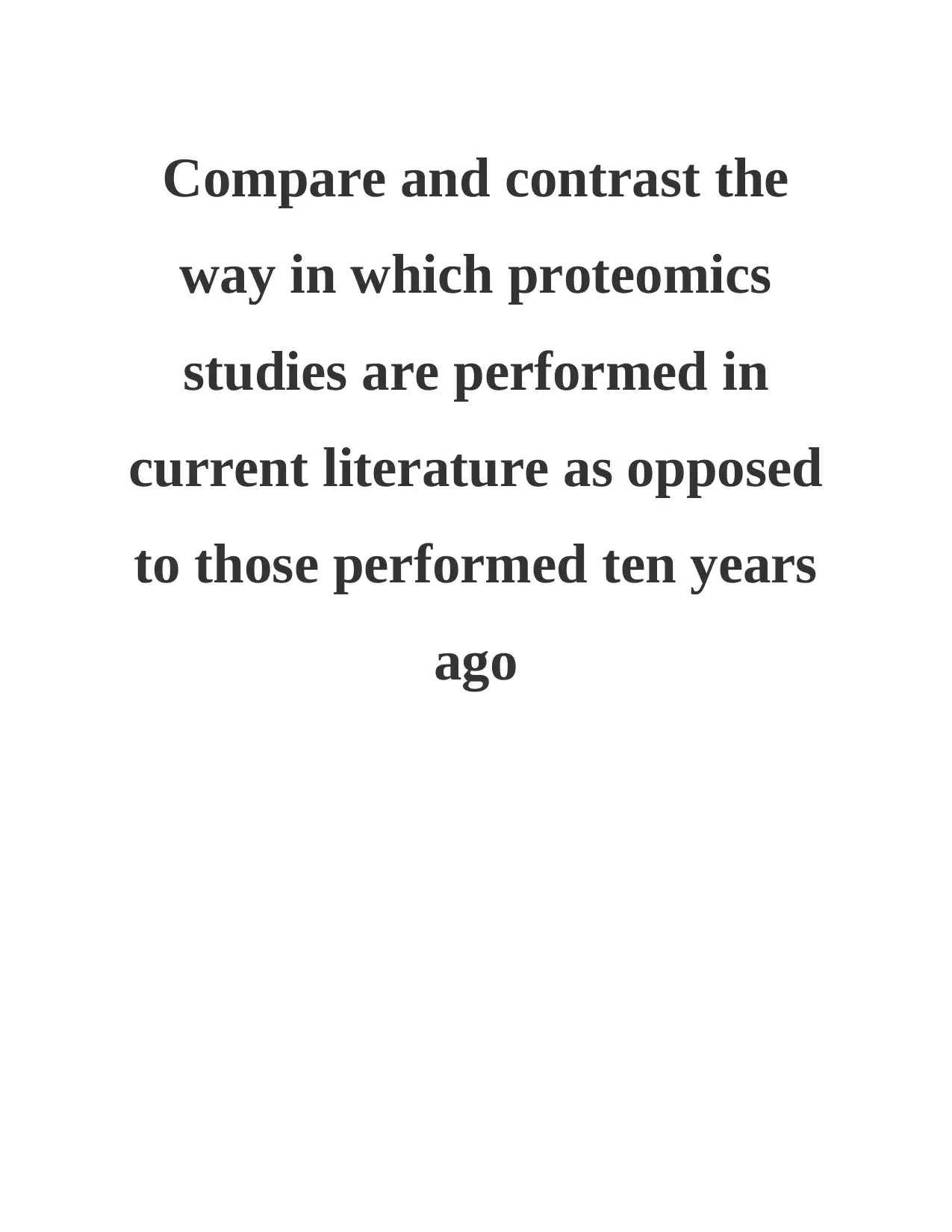
Compare and contrast the
way in which proteomics
studies are performed in
current literature as opposed
to those performed ten years
ago
way in which proteomics
studies are performed in
current literature as opposed
to those performed ten years
ago
Secure Best Marks with AI Grader
Need help grading? Try our AI Grader for instant feedback on your assignments.
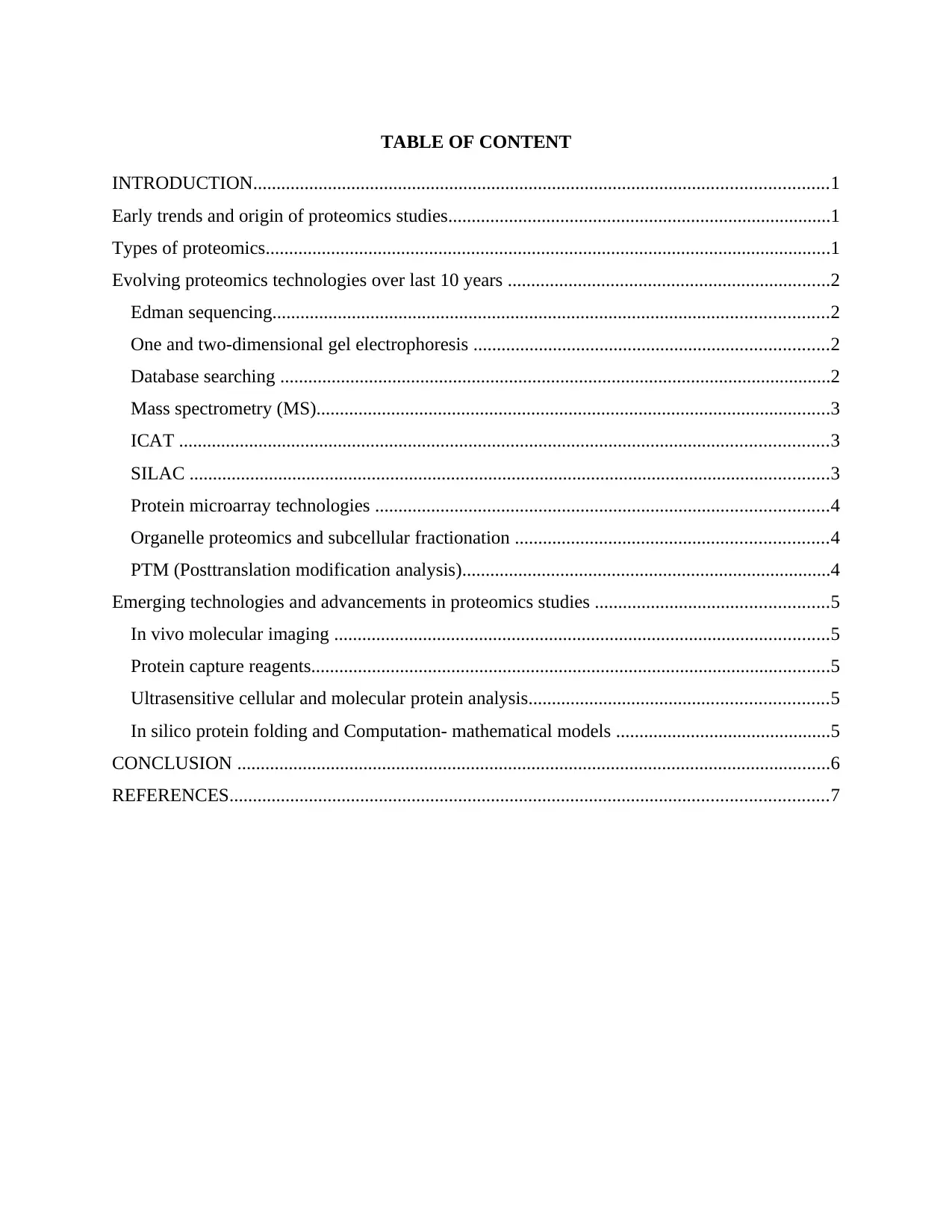
TABLE OF CONTENT
INTRODUCTION...........................................................................................................................1
Early trends and origin of proteomics studies..................................................................................1
Types of proteomics.........................................................................................................................1
Evolving proteomics technologies over last 10 years .....................................................................2
Edman sequencing.......................................................................................................................2
One and two-dimensional gel electrophoresis ............................................................................2
Database searching ......................................................................................................................2
Mass spectrometry (MS)..............................................................................................................3
ICAT ...........................................................................................................................................3
SILAC .........................................................................................................................................3
Protein microarray technologies .................................................................................................4
Organelle proteomics and subcellular fractionation ...................................................................4
PTM (Posttranslation modification analysis)...............................................................................4
Emerging technologies and advancements in proteomics studies ..................................................5
In vivo molecular imaging ..........................................................................................................5
Protein capture reagents...............................................................................................................5
Ultrasensitive cellular and molecular protein analysis................................................................5
In silico protein folding and Computation- mathematical models ..............................................5
CONCLUSION ...............................................................................................................................6
REFERENCES................................................................................................................................7
INTRODUCTION...........................................................................................................................1
Early trends and origin of proteomics studies..................................................................................1
Types of proteomics.........................................................................................................................1
Evolving proteomics technologies over last 10 years .....................................................................2
Edman sequencing.......................................................................................................................2
One and two-dimensional gel electrophoresis ............................................................................2
Database searching ......................................................................................................................2
Mass spectrometry (MS)..............................................................................................................3
ICAT ...........................................................................................................................................3
SILAC .........................................................................................................................................3
Protein microarray technologies .................................................................................................4
Organelle proteomics and subcellular fractionation ...................................................................4
PTM (Posttranslation modification analysis)...............................................................................4
Emerging technologies and advancements in proteomics studies ..................................................5
In vivo molecular imaging ..........................................................................................................5
Protein capture reagents...............................................................................................................5
Ultrasensitive cellular and molecular protein analysis................................................................5
In silico protein folding and Computation- mathematical models ..............................................5
CONCLUSION ...............................................................................................................................6
REFERENCES................................................................................................................................7
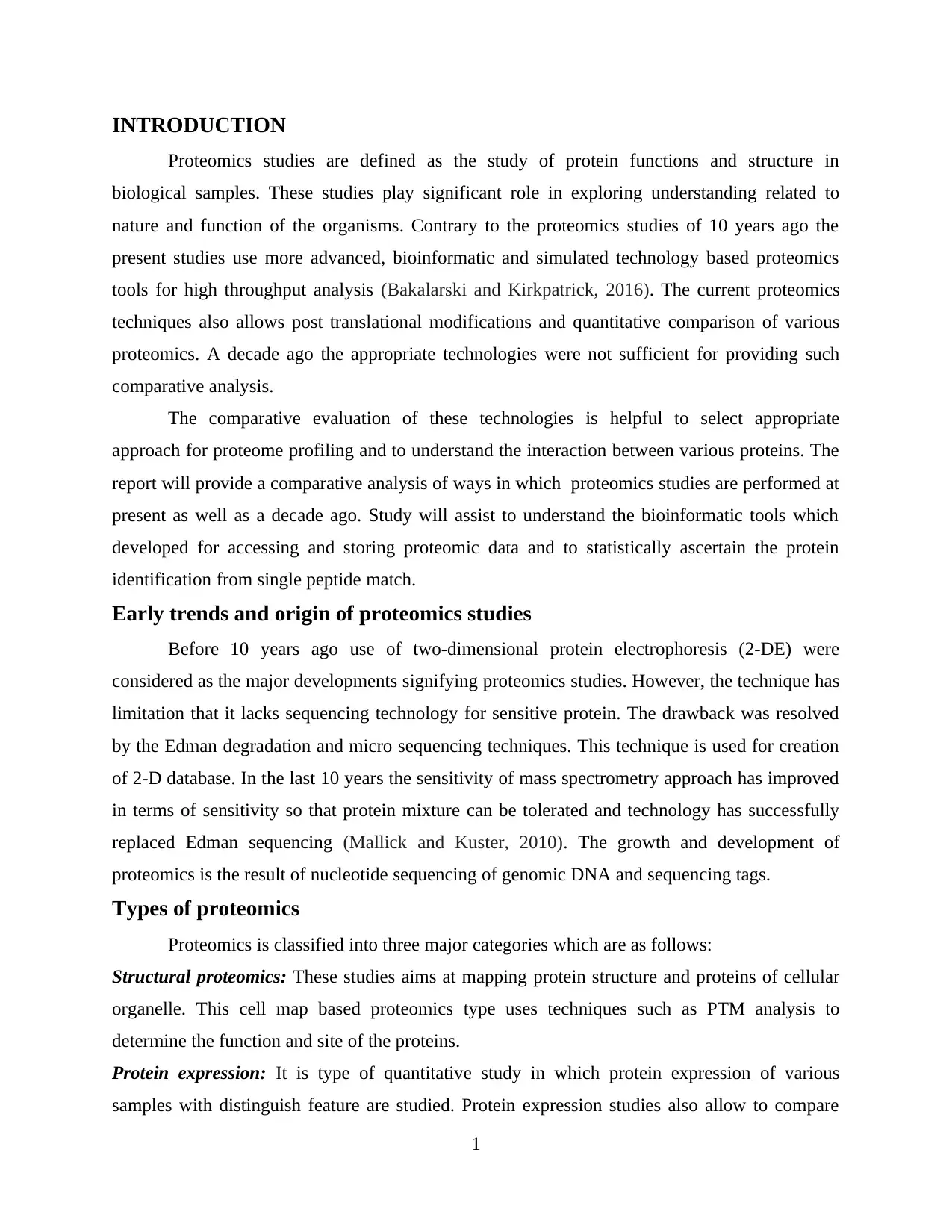
INTRODUCTION
Proteomics studies are defined as the study of protein functions and structure in
biological samples. These studies play significant role in exploring understanding related to
nature and function of the organisms. Contrary to the proteomics studies of 10 years ago the
present studies use more advanced, bioinformatic and simulated technology based proteomics
tools for high throughput analysis (Bakalarski and Kirkpatrick, 2016). The current proteomics
techniques also allows post translational modifications and quantitative comparison of various
proteomics. A decade ago the appropriate technologies were not sufficient for providing such
comparative analysis.
The comparative evaluation of these technologies is helpful to select appropriate
approach for proteome profiling and to understand the interaction between various proteins. The
report will provide a comparative analysis of ways in which proteomics studies are performed at
present as well as a decade ago. Study will assist to understand the bioinformatic tools which
developed for accessing and storing proteomic data and to statistically ascertain the protein
identification from single peptide match.
Early trends and origin of proteomics studies
Before 10 years ago use of two-dimensional protein electrophoresis (2-DE) were
considered as the major developments signifying proteomics studies. However, the technique has
limitation that it lacks sequencing technology for sensitive protein. The drawback was resolved
by the Edman degradation and micro sequencing techniques. This technique is used for creation
of 2-D database. In the last 10 years the sensitivity of mass spectrometry approach has improved
in terms of sensitivity so that protein mixture can be tolerated and technology has successfully
replaced Edman sequencing (Mallick and Kuster, 2010). The growth and development of
proteomics is the result of nucleotide sequencing of genomic DNA and sequencing tags.
Types of proteomics
Proteomics is classified into three major categories which are as follows:
Structural proteomics: These studies aims at mapping protein structure and proteins of cellular
organelle. This cell map based proteomics type uses techniques such as PTM analysis to
determine the function and site of the proteins.
Protein expression: It is type of quantitative study in which protein expression of various
samples with distinguish feature are studied. Protein expression studies also allow to compare
1
Proteomics studies are defined as the study of protein functions and structure in
biological samples. These studies play significant role in exploring understanding related to
nature and function of the organisms. Contrary to the proteomics studies of 10 years ago the
present studies use more advanced, bioinformatic and simulated technology based proteomics
tools for high throughput analysis (Bakalarski and Kirkpatrick, 2016). The current proteomics
techniques also allows post translational modifications and quantitative comparison of various
proteomics. A decade ago the appropriate technologies were not sufficient for providing such
comparative analysis.
The comparative evaluation of these technologies is helpful to select appropriate
approach for proteome profiling and to understand the interaction between various proteins. The
report will provide a comparative analysis of ways in which proteomics studies are performed at
present as well as a decade ago. Study will assist to understand the bioinformatic tools which
developed for accessing and storing proteomic data and to statistically ascertain the protein
identification from single peptide match.
Early trends and origin of proteomics studies
Before 10 years ago use of two-dimensional protein electrophoresis (2-DE) were
considered as the major developments signifying proteomics studies. However, the technique has
limitation that it lacks sequencing technology for sensitive protein. The drawback was resolved
by the Edman degradation and micro sequencing techniques. This technique is used for creation
of 2-D database. In the last 10 years the sensitivity of mass spectrometry approach has improved
in terms of sensitivity so that protein mixture can be tolerated and technology has successfully
replaced Edman sequencing (Mallick and Kuster, 2010). The growth and development of
proteomics is the result of nucleotide sequencing of genomic DNA and sequencing tags.
Types of proteomics
Proteomics is classified into three major categories which are as follows:
Structural proteomics: These studies aims at mapping protein structure and proteins of cellular
organelle. This cell map based proteomics type uses techniques such as PTM analysis to
determine the function and site of the proteins.
Protein expression: It is type of quantitative study in which protein expression of various
samples with distinguish feature are studied. Protein expression studies also allow to compare
1
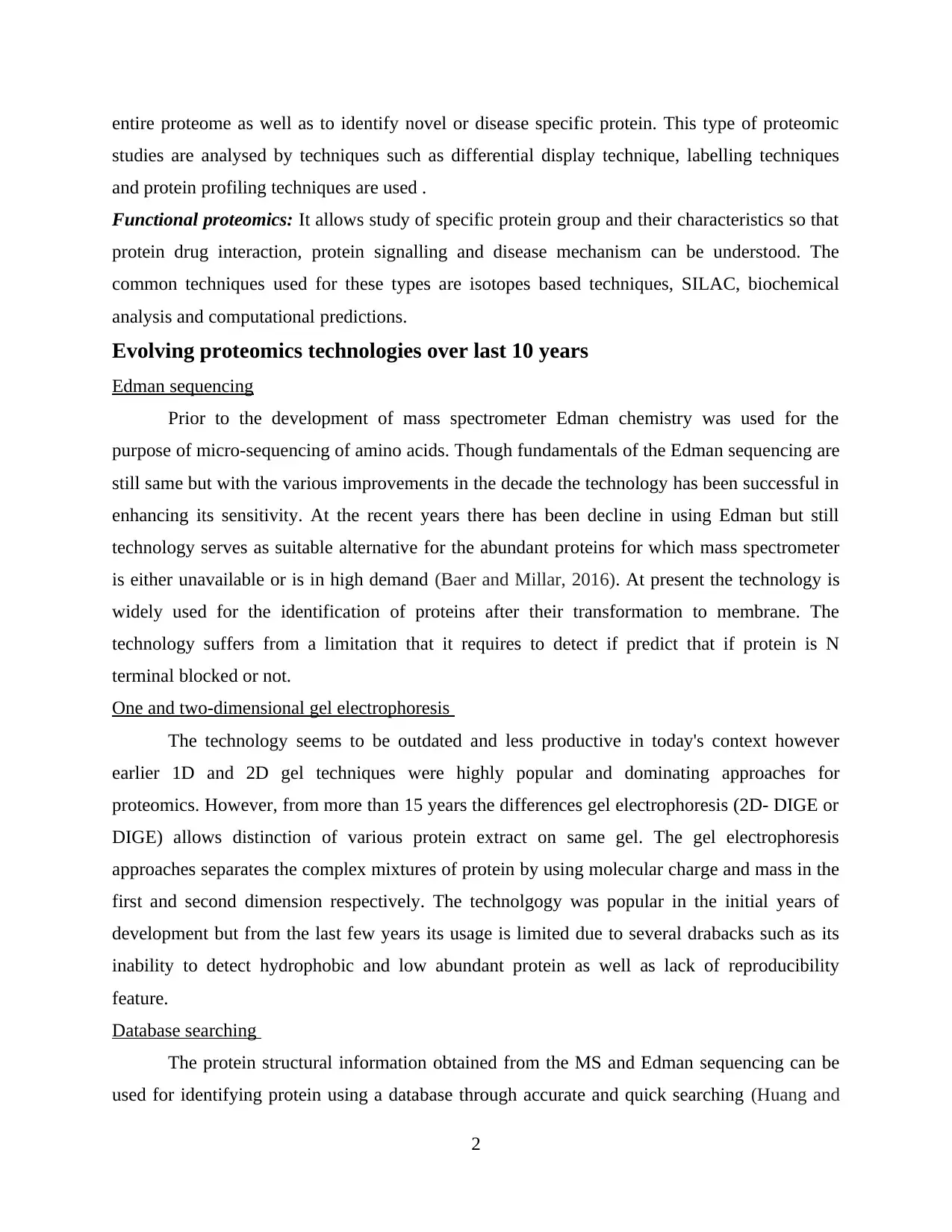
entire proteome as well as to identify novel or disease specific protein. This type of proteomic
studies are analysed by techniques such as differential display technique, labelling techniques
and protein profiling techniques are used .
Functional proteomics: It allows study of specific protein group and their characteristics so that
protein drug interaction, protein signalling and disease mechanism can be understood. The
common techniques used for these types are isotopes based techniques, SILAC, biochemical
analysis and computational predictions.
Evolving proteomics technologies over last 10 years
Edman sequencing
Prior to the development of mass spectrometer Edman chemistry was used for the
purpose of micro-sequencing of amino acids. Though fundamentals of the Edman sequencing are
still same but with the various improvements in the decade the technology has been successful in
enhancing its sensitivity. At the recent years there has been decline in using Edman but still
technology serves as suitable alternative for the abundant proteins for which mass spectrometer
is either unavailable or is in high demand (Baer and Millar, 2016). At present the technology is
widely used for the identification of proteins after their transformation to membrane. The
technology suffers from a limitation that it requires to detect if predict that if protein is N
terminal blocked or not.
One and two-dimensional gel electrophoresis
The technology seems to be outdated and less productive in today's context however
earlier 1D and 2D gel techniques were highly popular and dominating approaches for
proteomics. However, from more than 15 years the differences gel electrophoresis (2D- DIGE or
DIGE) allows distinction of various protein extract on same gel. The gel electrophoresis
approaches separates the complex mixtures of protein by using molecular charge and mass in the
first and second dimension respectively. The technolgogy was popular in the initial years of
development but from the last few years its usage is limited due to several drabacks such as its
inability to detect hydrophobic and low abundant protein as well as lack of reproducibility
feature.
Database searching
The protein structural information obtained from the MS and Edman sequencing can be
used for identifying protein using a database through accurate and quick searching (Huang and
2
studies are analysed by techniques such as differential display technique, labelling techniques
and protein profiling techniques are used .
Functional proteomics: It allows study of specific protein group and their characteristics so that
protein drug interaction, protein signalling and disease mechanism can be understood. The
common techniques used for these types are isotopes based techniques, SILAC, biochemical
analysis and computational predictions.
Evolving proteomics technologies over last 10 years
Edman sequencing
Prior to the development of mass spectrometer Edman chemistry was used for the
purpose of micro-sequencing of amino acids. Though fundamentals of the Edman sequencing are
still same but with the various improvements in the decade the technology has been successful in
enhancing its sensitivity. At the recent years there has been decline in using Edman but still
technology serves as suitable alternative for the abundant proteins for which mass spectrometer
is either unavailable or is in high demand (Baer and Millar, 2016). At present the technology is
widely used for the identification of proteins after their transformation to membrane. The
technology suffers from a limitation that it requires to detect if predict that if protein is N
terminal blocked or not.
One and two-dimensional gel electrophoresis
The technology seems to be outdated and less productive in today's context however
earlier 1D and 2D gel techniques were highly popular and dominating approaches for
proteomics. However, from more than 15 years the differences gel electrophoresis (2D- DIGE or
DIGE) allows distinction of various protein extract on same gel. The gel electrophoresis
approaches separates the complex mixtures of protein by using molecular charge and mass in the
first and second dimension respectively. The technolgogy was popular in the initial years of
development but from the last few years its usage is limited due to several drabacks such as its
inability to detect hydrophobic and low abundant protein as well as lack of reproducibility
feature.
Database searching
The protein structural information obtained from the MS and Edman sequencing can be
used for identifying protein using a database through accurate and quick searching (Huang and
2
Secure Best Marks with AI Grader
Need help grading? Try our AI Grader for instant feedback on your assignments.
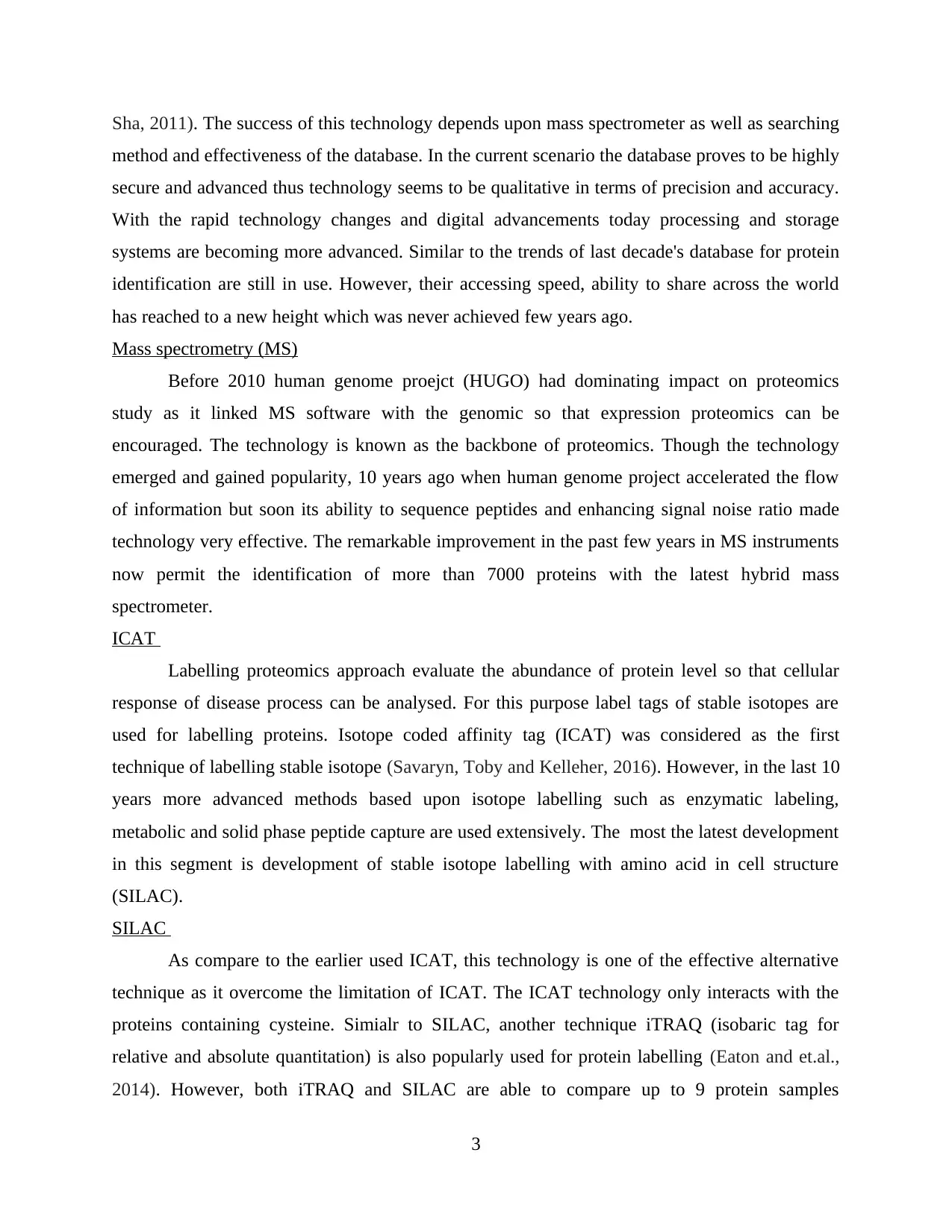
Sha, 2011). The success of this technology depends upon mass spectrometer as well as searching
method and effectiveness of the database. In the current scenario the database proves to be highly
secure and advanced thus technology seems to be qualitative in terms of precision and accuracy.
With the rapid technology changes and digital advancements today processing and storage
systems are becoming more advanced. Similar to the trends of last decade's database for protein
identification are still in use. However, their accessing speed, ability to share across the world
has reached to a new height which was never achieved few years ago.
Mass spectrometry (MS)
Before 2010 human genome proejct (HUGO) had dominating impact on proteomics
study as it linked MS software with the genomic so that expression proteomics can be
encouraged. The technology is known as the backbone of proteomics. Though the technology
emerged and gained popularity, 10 years ago when human genome project accelerated the flow
of information but soon its ability to sequence peptides and enhancing signal noise ratio made
technology very effective. The remarkable improvement in the past few years in MS instruments
now permit the identification of more than 7000 proteins with the latest hybrid mass
spectrometer.
ICAT
Labelling proteomics approach evaluate the abundance of protein level so that cellular
response of disease process can be analysed. For this purpose label tags of stable isotopes are
used for labelling proteins. Isotope coded affinity tag (ICAT) was considered as the first
technique of labelling stable isotope (Savaryn, Toby and Kelleher, 2016). However, in the last 10
years more advanced methods based upon isotope labelling such as enzymatic labeling,
metabolic and solid phase peptide capture are used extensively. The most the latest development
in this segment is development of stable isotope labelling with amino acid in cell structure
(SILAC).
SILAC
As compare to the earlier used ICAT, this technology is one of the effective alternative
technique as it overcome the limitation of ICAT. The ICAT technology only interacts with the
proteins containing cysteine. Simialr to SILAC, another technique iTRAQ (isobaric tag for
relative and absolute quantitation) is also popularly used for protein labelling (Eaton and et.al.,
2014). However, both iTRAQ and SILAC are able to compare up to 9 protein samples
3
method and effectiveness of the database. In the current scenario the database proves to be highly
secure and advanced thus technology seems to be qualitative in terms of precision and accuracy.
With the rapid technology changes and digital advancements today processing and storage
systems are becoming more advanced. Similar to the trends of last decade's database for protein
identification are still in use. However, their accessing speed, ability to share across the world
has reached to a new height which was never achieved few years ago.
Mass spectrometry (MS)
Before 2010 human genome proejct (HUGO) had dominating impact on proteomics
study as it linked MS software with the genomic so that expression proteomics can be
encouraged. The technology is known as the backbone of proteomics. Though the technology
emerged and gained popularity, 10 years ago when human genome project accelerated the flow
of information but soon its ability to sequence peptides and enhancing signal noise ratio made
technology very effective. The remarkable improvement in the past few years in MS instruments
now permit the identification of more than 7000 proteins with the latest hybrid mass
spectrometer.
ICAT
Labelling proteomics approach evaluate the abundance of protein level so that cellular
response of disease process can be analysed. For this purpose label tags of stable isotopes are
used for labelling proteins. Isotope coded affinity tag (ICAT) was considered as the first
technique of labelling stable isotope (Savaryn, Toby and Kelleher, 2016). However, in the last 10
years more advanced methods based upon isotope labelling such as enzymatic labeling,
metabolic and solid phase peptide capture are used extensively. The most the latest development
in this segment is development of stable isotope labelling with amino acid in cell structure
(SILAC).
SILAC
As compare to the earlier used ICAT, this technology is one of the effective alternative
technique as it overcome the limitation of ICAT. The ICAT technology only interacts with the
proteins containing cysteine. Simialr to SILAC, another technique iTRAQ (isobaric tag for
relative and absolute quantitation) is also popularly used for protein labelling (Eaton and et.al.,
2014). However, both iTRAQ and SILAC are able to compare up to 9 protein samples
3
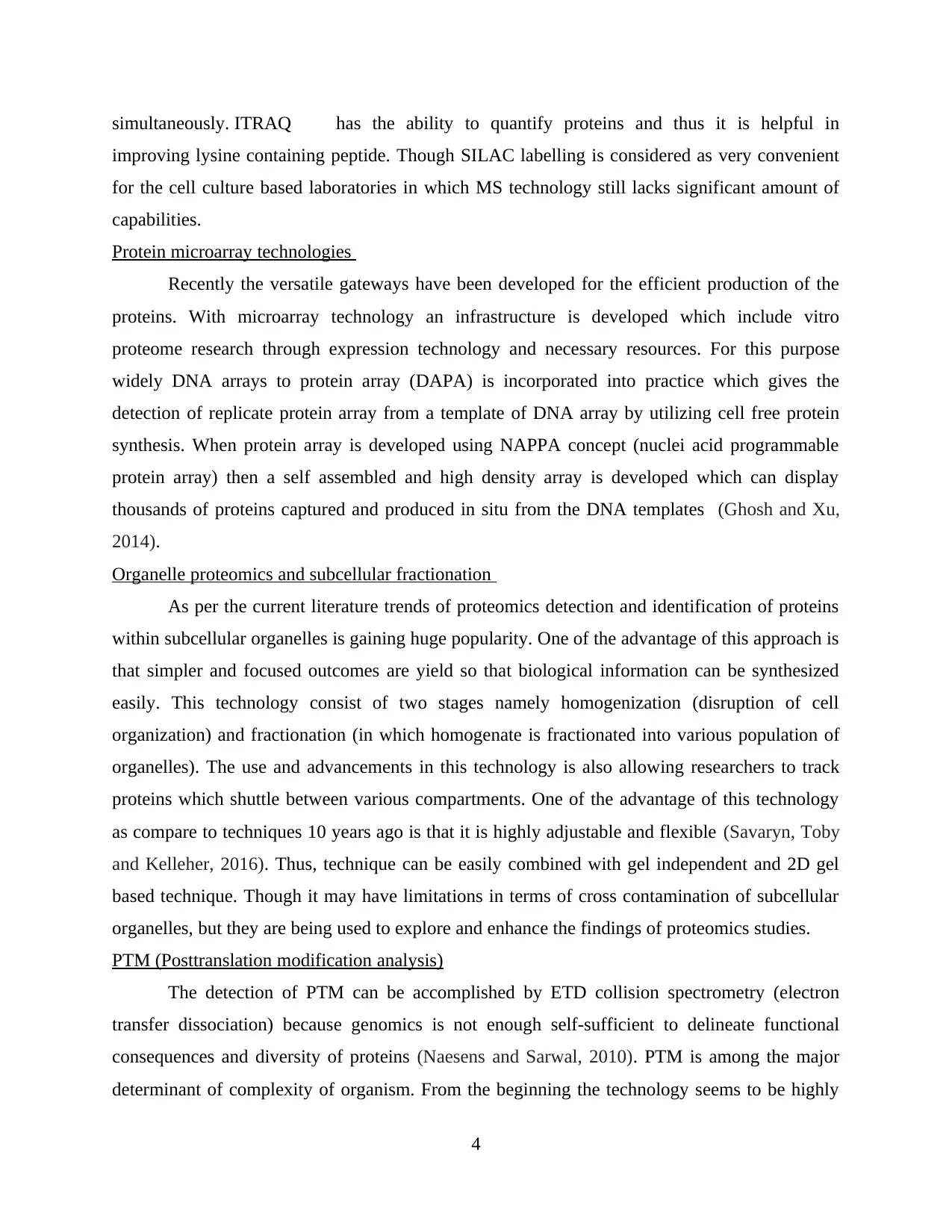
simultaneously. ITRAQ has the ability to quantify proteins and thus it is helpful in
improving lysine containing peptide. Though SILAC labelling is considered as very convenient
for the cell culture based laboratories in which MS technology still lacks significant amount of
capabilities.
Protein microarray technologies
Recently the versatile gateways have been developed for the efficient production of the
proteins. With microarray technology an infrastructure is developed which include vitro
proteome research through expression technology and necessary resources. For this purpose
widely DNA arrays to protein array (DAPA) is incorporated into practice which gives the
detection of replicate protein array from a template of DNA array by utilizing cell free protein
synthesis. When protein array is developed using NAPPA concept (nuclei acid programmable
protein array) then a self assembled and high density array is developed which can display
thousands of proteins captured and produced in situ from the DNA templates (Ghosh and Xu,
2014).
Organelle proteomics and subcellular fractionation
As per the current literature trends of proteomics detection and identification of proteins
within subcellular organelles is gaining huge popularity. One of the advantage of this approach is
that simpler and focused outcomes are yield so that biological information can be synthesized
easily. This technology consist of two stages namely homogenization (disruption of cell
organization) and fractionation (in which homogenate is fractionated into various population of
organelles). The use and advancements in this technology is also allowing researchers to track
proteins which shuttle between various compartments. One of the advantage of this technology
as compare to techniques 10 years ago is that it is highly adjustable and flexible (Savaryn, Toby
and Kelleher, 2016). Thus, technique can be easily combined with gel independent and 2D gel
based technique. Though it may have limitations in terms of cross contamination of subcellular
organelles, but they are being used to explore and enhance the findings of proteomics studies.
PTM (Posttranslation modification analysis)
The detection of PTM can be accomplished by ETD collision spectrometry (electron
transfer dissociation) because genomics is not enough self-sufficient to delineate functional
consequences and diversity of proteins (Naesens and Sarwal, 2010). PTM is among the major
determinant of complexity of organism. From the beginning the technology seems to be highly
4
improving lysine containing peptide. Though SILAC labelling is considered as very convenient
for the cell culture based laboratories in which MS technology still lacks significant amount of
capabilities.
Protein microarray technologies
Recently the versatile gateways have been developed for the efficient production of the
proteins. With microarray technology an infrastructure is developed which include vitro
proteome research through expression technology and necessary resources. For this purpose
widely DNA arrays to protein array (DAPA) is incorporated into practice which gives the
detection of replicate protein array from a template of DNA array by utilizing cell free protein
synthesis. When protein array is developed using NAPPA concept (nuclei acid programmable
protein array) then a self assembled and high density array is developed which can display
thousands of proteins captured and produced in situ from the DNA templates (Ghosh and Xu,
2014).
Organelle proteomics and subcellular fractionation
As per the current literature trends of proteomics detection and identification of proteins
within subcellular organelles is gaining huge popularity. One of the advantage of this approach is
that simpler and focused outcomes are yield so that biological information can be synthesized
easily. This technology consist of two stages namely homogenization (disruption of cell
organization) and fractionation (in which homogenate is fractionated into various population of
organelles). The use and advancements in this technology is also allowing researchers to track
proteins which shuttle between various compartments. One of the advantage of this technology
as compare to techniques 10 years ago is that it is highly adjustable and flexible (Savaryn, Toby
and Kelleher, 2016). Thus, technique can be easily combined with gel independent and 2D gel
based technique. Though it may have limitations in terms of cross contamination of subcellular
organelles, but they are being used to explore and enhance the findings of proteomics studies.
PTM (Posttranslation modification analysis)
The detection of PTM can be accomplished by ETD collision spectrometry (electron
transfer dissociation) because genomics is not enough self-sufficient to delineate functional
consequences and diversity of proteins (Naesens and Sarwal, 2010). PTM is among the major
determinant of complexity of organism. From the beginning the technology seems to be highly
4
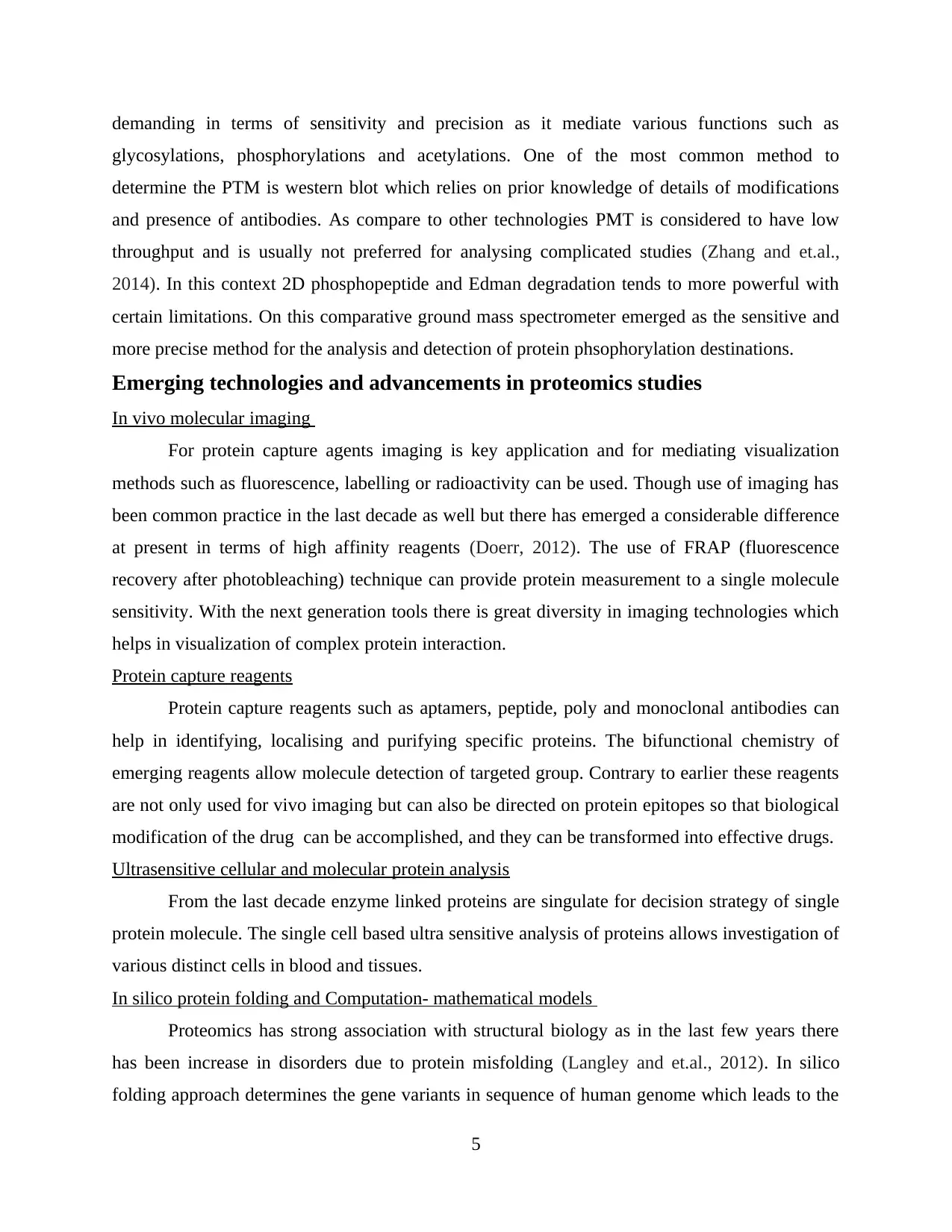
demanding in terms of sensitivity and precision as it mediate various functions such as
glycosylations, phosphorylations and acetylations. One of the most common method to
determine the PTM is western blot which relies on prior knowledge of details of modifications
and presence of antibodies. As compare to other technologies PMT is considered to have low
throughput and is usually not preferred for analysing complicated studies (Zhang and et.al.,
2014). In this context 2D phosphopeptide and Edman degradation tends to more powerful with
certain limitations. On this comparative ground mass spectrometer emerged as the sensitive and
more precise method for the analysis and detection of protein phsophorylation destinations.
Emerging technologies and advancements in proteomics studies
In vivo molecular imaging
For protein capture agents imaging is key application and for mediating visualization
methods such as fluorescence, labelling or radioactivity can be used. Though use of imaging has
been common practice in the last decade as well but there has emerged a considerable difference
at present in terms of high affinity reagents (Doerr, 2012). The use of FRAP (fluorescence
recovery after photobleaching) technique can provide protein measurement to a single molecule
sensitivity. With the next generation tools there is great diversity in imaging technologies which
helps in visualization of complex protein interaction.
Protein capture reagents
Protein capture reagents such as aptamers, peptide, poly and monoclonal antibodies can
help in identifying, localising and purifying specific proteins. The bifunctional chemistry of
emerging reagents allow molecule detection of targeted group. Contrary to earlier these reagents
are not only used for vivo imaging but can also be directed on protein epitopes so that biological
modification of the drug can be accomplished, and they can be transformed into effective drugs.
Ultrasensitive cellular and molecular protein analysis
From the last decade enzyme linked proteins are singulate for decision strategy of single
protein molecule. The single cell based ultra sensitive analysis of proteins allows investigation of
various distinct cells in blood and tissues.
In silico protein folding and Computation- mathematical models
Proteomics has strong association with structural biology as in the last few years there
has been increase in disorders due to protein misfolding (Langley and et.al., 2012). In silico
folding approach determines the gene variants in sequence of human genome which leads to the
5
glycosylations, phosphorylations and acetylations. One of the most common method to
determine the PTM is western blot which relies on prior knowledge of details of modifications
and presence of antibodies. As compare to other technologies PMT is considered to have low
throughput and is usually not preferred for analysing complicated studies (Zhang and et.al.,
2014). In this context 2D phosphopeptide and Edman degradation tends to more powerful with
certain limitations. On this comparative ground mass spectrometer emerged as the sensitive and
more precise method for the analysis and detection of protein phsophorylation destinations.
Emerging technologies and advancements in proteomics studies
In vivo molecular imaging
For protein capture agents imaging is key application and for mediating visualization
methods such as fluorescence, labelling or radioactivity can be used. Though use of imaging has
been common practice in the last decade as well but there has emerged a considerable difference
at present in terms of high affinity reagents (Doerr, 2012). The use of FRAP (fluorescence
recovery after photobleaching) technique can provide protein measurement to a single molecule
sensitivity. With the next generation tools there is great diversity in imaging technologies which
helps in visualization of complex protein interaction.
Protein capture reagents
Protein capture reagents such as aptamers, peptide, poly and monoclonal antibodies can
help in identifying, localising and purifying specific proteins. The bifunctional chemistry of
emerging reagents allow molecule detection of targeted group. Contrary to earlier these reagents
are not only used for vivo imaging but can also be directed on protein epitopes so that biological
modification of the drug can be accomplished, and they can be transformed into effective drugs.
Ultrasensitive cellular and molecular protein analysis
From the last decade enzyme linked proteins are singulate for decision strategy of single
protein molecule. The single cell based ultra sensitive analysis of proteins allows investigation of
various distinct cells in blood and tissues.
In silico protein folding and Computation- mathematical models
Proteomics has strong association with structural biology as in the last few years there
has been increase in disorders due to protein misfolding (Langley and et.al., 2012). In silico
folding approach determines the gene variants in sequence of human genome which leads to the
5
Paraphrase This Document
Need a fresh take? Get an instant paraphrase of this document with our AI Paraphraser
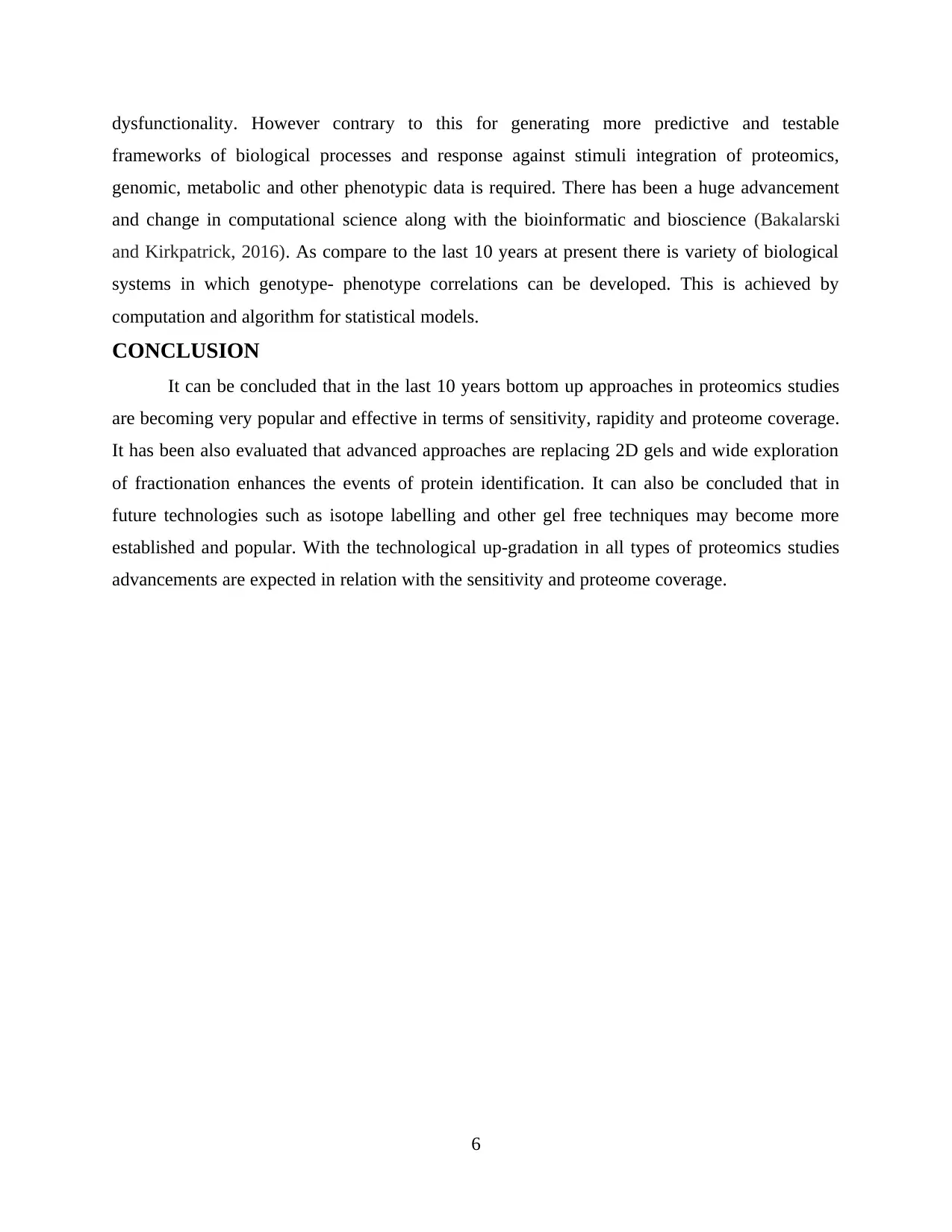
dysfunctionality. However contrary to this for generating more predictive and testable
frameworks of biological processes and response against stimuli integration of proteomics,
genomic, metabolic and other phenotypic data is required. There has been a huge advancement
and change in computational science along with the bioinformatic and bioscience (Bakalarski
and Kirkpatrick, 2016). As compare to the last 10 years at present there is variety of biological
systems in which genotype- phenotype correlations can be developed. This is achieved by
computation and algorithm for statistical models.
CONCLUSION
It can be concluded that in the last 10 years bottom up approaches in proteomics studies
are becoming very popular and effective in terms of sensitivity, rapidity and proteome coverage.
It has been also evaluated that advanced approaches are replacing 2D gels and wide exploration
of fractionation enhances the events of protein identification. It can also be concluded that in
future technologies such as isotope labelling and other gel free techniques may become more
established and popular. With the technological up-gradation in all types of proteomics studies
advancements are expected in relation with the sensitivity and proteome coverage.
6
frameworks of biological processes and response against stimuli integration of proteomics,
genomic, metabolic and other phenotypic data is required. There has been a huge advancement
and change in computational science along with the bioinformatic and bioscience (Bakalarski
and Kirkpatrick, 2016). As compare to the last 10 years at present there is variety of biological
systems in which genotype- phenotype correlations can be developed. This is achieved by
computation and algorithm for statistical models.
CONCLUSION
It can be concluded that in the last 10 years bottom up approaches in proteomics studies
are becoming very popular and effective in terms of sensitivity, rapidity and proteome coverage.
It has been also evaluated that advanced approaches are replacing 2D gels and wide exploration
of fractionation enhances the events of protein identification. It can also be concluded that in
future technologies such as isotope labelling and other gel free techniques may become more
established and popular. With the technological up-gradation in all types of proteomics studies
advancements are expected in relation with the sensitivity and proteome coverage.
6
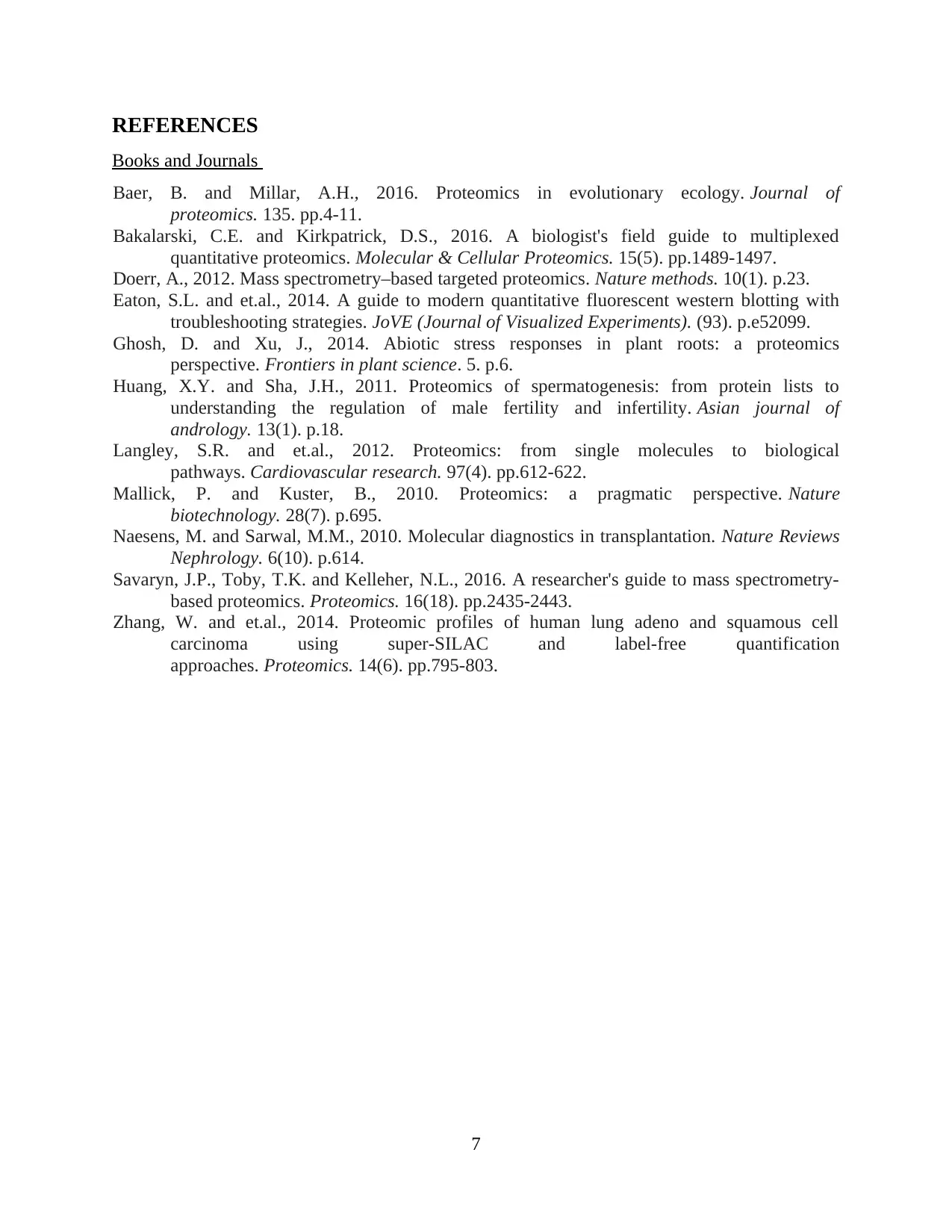
REFERENCES
Books and Journals
Baer, B. and Millar, A.H., 2016. Proteomics in evolutionary ecology. Journal of
proteomics. 135. pp.4-11.
Bakalarski, C.E. and Kirkpatrick, D.S., 2016. A biologist's field guide to multiplexed
quantitative proteomics. Molecular & Cellular Proteomics. 15(5). pp.1489-1497.
Doerr, A., 2012. Mass spectrometry–based targeted proteomics. Nature methods. 10(1). p.23.
Eaton, S.L. and et.al., 2014. A guide to modern quantitative fluorescent western blotting with
troubleshooting strategies. JoVE (Journal of Visualized Experiments). (93). p.e52099.
Ghosh, D. and Xu, J., 2014. Abiotic stress responses in plant roots: a proteomics
perspective. Frontiers in plant science. 5. p.6.
Huang, X.Y. and Sha, J.H., 2011. Proteomics of spermatogenesis: from protein lists to
understanding the regulation of male fertility and infertility. Asian journal of
andrology. 13(1). p.18.
Langley, S.R. and et.al., 2012. Proteomics: from single molecules to biological
pathways. Cardiovascular research. 97(4). pp.612-622.
Mallick, P. and Kuster, B., 2010. Proteomics: a pragmatic perspective. Nature
biotechnology. 28(7). p.695.
Naesens, M. and Sarwal, M.M., 2010. Molecular diagnostics in transplantation. Nature Reviews
Nephrology. 6(10). p.614.
Savaryn, J.P., Toby, T.K. and Kelleher, N.L., 2016. A researcher's guide to mass spectrometry‐
based proteomics. Proteomics. 16(18). pp.2435-2443.
Zhang, W. and et.al., 2014. Proteomic profiles of human lung adeno and squamous cell
carcinoma using super‐SILAC and label‐free quantification
approaches. Proteomics. 14(6). pp.795-803.
7
Books and Journals
Baer, B. and Millar, A.H., 2016. Proteomics in evolutionary ecology. Journal of
proteomics. 135. pp.4-11.
Bakalarski, C.E. and Kirkpatrick, D.S., 2016. A biologist's field guide to multiplexed
quantitative proteomics. Molecular & Cellular Proteomics. 15(5). pp.1489-1497.
Doerr, A., 2012. Mass spectrometry–based targeted proteomics. Nature methods. 10(1). p.23.
Eaton, S.L. and et.al., 2014. A guide to modern quantitative fluorescent western blotting with
troubleshooting strategies. JoVE (Journal of Visualized Experiments). (93). p.e52099.
Ghosh, D. and Xu, J., 2014. Abiotic stress responses in plant roots: a proteomics
perspective. Frontiers in plant science. 5. p.6.
Huang, X.Y. and Sha, J.H., 2011. Proteomics of spermatogenesis: from protein lists to
understanding the regulation of male fertility and infertility. Asian journal of
andrology. 13(1). p.18.
Langley, S.R. and et.al., 2012. Proteomics: from single molecules to biological
pathways. Cardiovascular research. 97(4). pp.612-622.
Mallick, P. and Kuster, B., 2010. Proteomics: a pragmatic perspective. Nature
biotechnology. 28(7). p.695.
Naesens, M. and Sarwal, M.M., 2010. Molecular diagnostics in transplantation. Nature Reviews
Nephrology. 6(10). p.614.
Savaryn, J.P., Toby, T.K. and Kelleher, N.L., 2016. A researcher's guide to mass spectrometry‐
based proteomics. Proteomics. 16(18). pp.2435-2443.
Zhang, W. and et.al., 2014. Proteomic profiles of human lung adeno and squamous cell
carcinoma using super‐SILAC and label‐free quantification
approaches. Proteomics. 14(6). pp.795-803.
7

8
Secure Best Marks with AI Grader
Need help grading? Try our AI Grader for instant feedback on your assignments.

9

10

11
1 out of 13
Your All-in-One AI-Powered Toolkit for Academic Success.
+13062052269
info@desklib.com
Available 24*7 on WhatsApp / Email
![[object Object]](/_next/static/media/star-bottom.7253800d.svg)
Unlock your academic potential
© 2024 | Zucol Services PVT LTD | All rights reserved.

